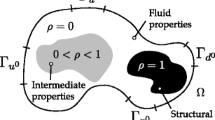Abstract
The continuous adjoint method is formulated and utilized for the optimization of a static mixing device. The CFD tool used for the simulations is based on a two-phase model governing flows of two miscible fluids. The formulation of the corresponding continuous adjoint problem is presented and the computed gradients are utilized in an optimization loop. In specific, a multi-objective optimization problem is formulated and solved for maximum mixture uniformity at the outlet and minimum total pressure losses inside a static mixing device. The weighted sum of these two quantities of interest is the objective function to be minimized by solving a single-objective problem. Through the solution of a number of optimization problems, with different weights each, the Pareto front of optimal solutions is computed. Two optimization approaches are employed taking the manufacturability of the final shape into consideration, giving rise to different optimal designs to be discussed and compared. Differences in the efficiency and the optimal shapes between the two approaches are thoroughly discussed and compared.














Similar content being viewed by others
References
Alexias P, de Villiers E (2019) Gradient projection, constraints and surface regularization methods in adjoint shape optimization. Springer, Cham, pp 3–17
Anderson WK, Venkatakrishnan V (1999) Aerodynamic design optimization on unstructured grids with a continuous adjoint formulation. Comput Fluids 28(4):443–480
Biancolini ME (2017) Fast radial basis functions for engineering applications. Springer, Cham
Brennen C (2005) Fundamentals of multiphase flow. Cambridge University Press, Cambridge
Byrde O, Sawley ML (1999) Optimization of a kenics static mixer for non-creeping flow conditions. Chem Eng J 72(2):163–169
Cussler EL (2009) Values of diffusion coefficients. Cambridge series in chemical engineering, 3rd edn. Cambridge University Press, Cambridge, pp 117–160
Drew DA (1983) Mathematical modeling of two-phase flow. Annu Rev Fluid Mech 15(1):261–291
Farrell PE, Maddison JR (2010) Conservative interpolation between volume meshes by local galerkin projection. Comput Methods Appl Mech Eng 200:89–100
Hanada T, Kuroda K, Takahashi K (2016) CFD geometrical optimization to improve mixing performance of axial mixer. Chem Eng Sci 144:144–152
Hirschberg S, Koubek R, Moser F, Schöck J (2009) An improvement of the sulzer smx\(^{{\rm TM}}\) static mixer significantly reducing the pressure drop. Chem Eng Res Des 87(4):524–532 (13th European Conference on Mixing: New developments towards more efficient and sustainable operations)
Hirt CW, Nichols BD (1981) Volume of fluid (VOF) method for the dynamics of free boundaries. J Comput Phys 39(1):201–225
Ishii M, Hibiki T (2011) Thermo-fluid dynamics of two-phase flow. Springer, New York
Jameson A (1988) Aerodynamic design via control theory. J Sci Comput 3(3):233–260
Kavvadias IS, Papoutsis-Kiachagias EM, Giannakoglou KC (2015) On the proper treatment of grid sensitivities in continuous adjoint methods for shape optimization. J Comput Phys 301:1–18
Manninen M (1996) On the mixture model for multiphase flow. Technical Research Centre of Finland, Espoo
Martins JRRA, Sturdza P, Alonso JJ (2003) The complex-step derivative approximation. ACM Trans Math Softw 29(3):245–262
Nocedal J (2006) Numerical optimization. Springer, New York
Papoutsis-Kiachagias EM, Giannakoglou KC (2014) Continuous adjoint methods for turbulent flows, applied to shape and topology optimization: industrial applications. Arch Comput Methods Eng 23(2):255–299
Pironneau O (1984) Optimal shape design for elliptic systems. Springer, Berlin
Rall L (1981) Automatic differentiation: techniques and applications. Springer, Berlin
Regner M, Östergren K, Trägårdh C (2006) Effects of geometry and flow rate on secondary flow and the mixing process in static mixers—a numerical study. Chem Eng Sci 61(18):6133–6141
Song H, Han SP (2005) A general correlation for pressure drop in a kenics static mixer. Chem Eng Sci 60(21):5696–5704
Acknowledgements
Parts of this work have been conducted within the IODA project (http://ioda.sems.qmul.ac.uk), funded by the European Union HORIZON 2020 Framework Programme for Research and Innovation under Grant Agreement No. 642959.
Author information
Authors and Affiliations
Corresponding author
Additional information
Publisher's Note
Springer Nature remains neutral with regard to jurisdictional claims in published maps and institutional affiliations.
Rights and permissions
About this article
Cite this article
Alexias, P., Giannakoglou, K.C. Optimization of a static mixing device using the continuous adjoint to a two-phase mixing model. Optim Eng 21, 631–650 (2020). https://doi.org/10.1007/s11081-019-09466-x
Received:
Revised:
Accepted:
Published:
Issue Date:
DOI: https://doi.org/10.1007/s11081-019-09466-x




